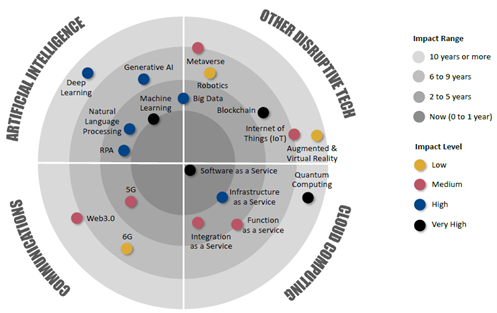As the demand for skilled workers evolves, emerging technologies could transform the way that staffing firms operate as well as the markets they operate within. This makes it imperative for companies to think hard about how, when and where to adopt new tech. SIA’s Impact of Emerging Technology on Staffing report suggests four main groups of emerging technologies to consider: artificial intelligence (AI), communications, cloud computing and other disruptive tech such as blockchain, metaverse and Internet of Things (IoT). This article discusses an emerging technology from each group identified within the report as having the most impact on staffing firms’ internal processes.
AI — Machine Learning
Of all emerging AI technologies identified, machine learning is expected to impact staffing firms’ internal processes the most. In machine learning, algorithms and statistical techniques enable computers to learn from data, making decisions/predictions that improve performance over time. The three main types of machine learning include supervised learning, where the algorithm trains on labelled data; unsupervised learning, where the algorithm uses unlabelled data; and reinforcement learning, where the algorithm learns by trial and error, receiving rewards or penalties for its actions.
Staffing firms can use machine learning for candidate matching, where algorithms scan through candidate CVs, filtering key information or predicting candidate suitability. This enables recruiters to create candidate shortlists quickly while reducing human error. Other benefits could include the automation of repetitive tasks; improved decision-making through insights into candidate performance, skill levels and potential cultural fit; personalised candidate and customer experience; and development of reskilling and upskilling services.
Cloud Computing — SaaS
Among cloud computing technologies, SIA identified software as a service (SaaS) as having the most significant impact on staffing firm processes. SaaS is a cloud computing model in which software applications are provided over the internet as a service. Users can access the software and its features through a web browser or a dedicated application. The software is hosted and maintained by the service provider, which ensures it’s up to date, secure and available to users. SaaS offers lower upfront costs, no installation requirements, ease of scaling up the technology and automatic updates. However, it does require reliance on third-party vendors and internet connectivity.
SaaS is the most mature emerging cloud computing technology affecting staffing firms, with the hosting of software applications on remote servers having eclipsed the use of on-premise software. The most apparent use of SaaS is in providing front- and back-office software, but it has significant applications in other parts of the staffing tech stack as well as in the delivery of vendor management systems. The global pandemic underscored the advantages of hosting software on remote servers instead of on premise.
Communications — 5G
The two most important technologies in this category are 5G and 6G. 5G is the planned successor to the 4G networks, which provide connectivity to most current mobile phones. The adoption of 5G began in 2019 and gained momentum in developed economies in 2022 and 2023. Broad implications of 5G include faster internet, better coverage in regional and rural areas, and the ability to move more data on different devices. For staffing firms, the 5G rollout is likely to mean further support for remote work, the deployment of more industry-specific apps (e.g., time and attendance) in areas of low coverage and increased support for platform technology and other mobile applications.
Currently in its R&D phase, 6Gis 5G’s planned successor, with a rollout expected to begin around 2030. Currently, there are no universally accepted standards for 6G. However, 6G will likely result in improved download speeds (10 times the speed of 5G), elimination of latency, reduced mobile network congestion and support the adoption of other emerging technologies such as virtual reality, augmented reality, metaverse and AI. The near-instant and unrestricted wireless connectivity that 6G promises to provide will change how staffing firms with remote networks and remote staff operate. 6G will also support the adoption of other emerging technologies such as big data, blockchain and AI.
Other Technologies — Blockchain
Among other technologies, blockchain has the greatest potential impact on internal staffing firm processes, with results expected in the next six to nine years. Blockchain is digital ledger technology enabling multiple parties to share and access a single, decentralised database to securely store and transfer digital assets or information without a centralised intermediary or authority. The database, or “blockchain,” comprises a continuously growing list of records, or “blocks,” linked and secured using cryptography. Each block contains a timestamp and a reference to the previous block in the chain, creating a secure, transparent and tamper-proof record of all transactions.
This technology has the potential to transform how information is transferred and managed in a wide range of industries, with a wide range of applications in supply chain management, voting systems and digital identity verification. Meanwhile, staffing firms’ growing interest in self-sovereign solutions (SSI) is fuelling the development of credentialing solutions built on blockchain. Using these solutions will improve efficiency and lower staffing firms’ costs when processing candidate data. Blockchain will also have uses for payroll, especially when paying workers abroad and providing on-demand pay. Managed service providers are also expected to be impacted by the disintermediation that blockchain is likely to create across supply chains.
SIA’s Impact of Emerging Technology on Staffing technology adoption checklist includes evaluating benefits, assessing risks, considering costs, reviewing competition and seeking expert advice. SIA corporate members can access the full report for further information, including details on other technologies displayed in the graphic above.








